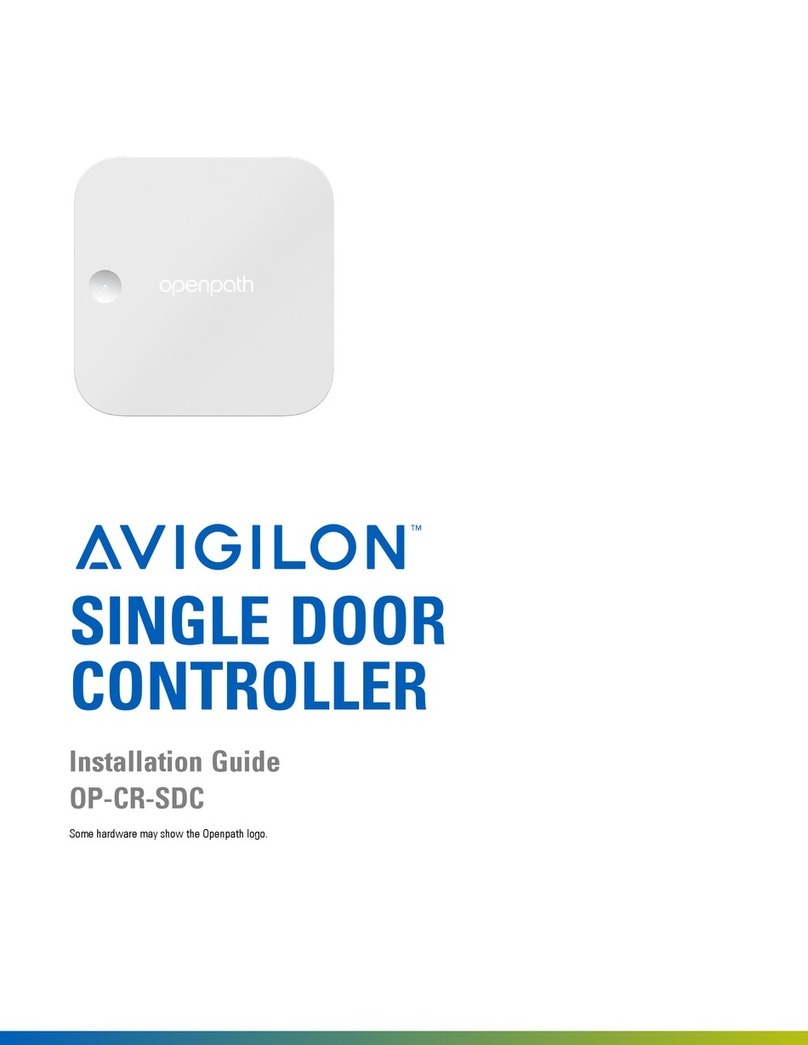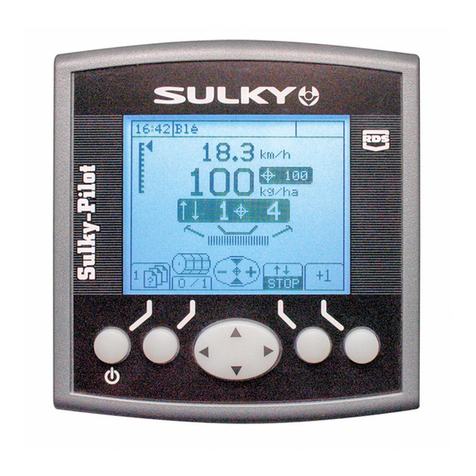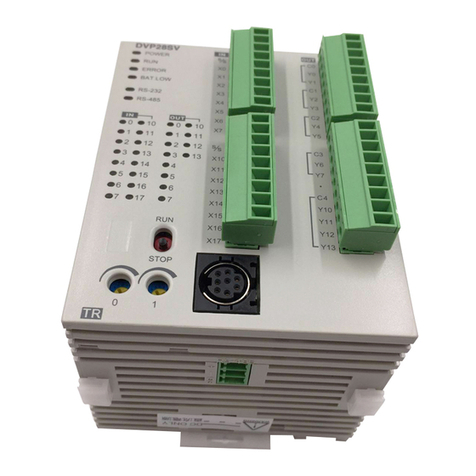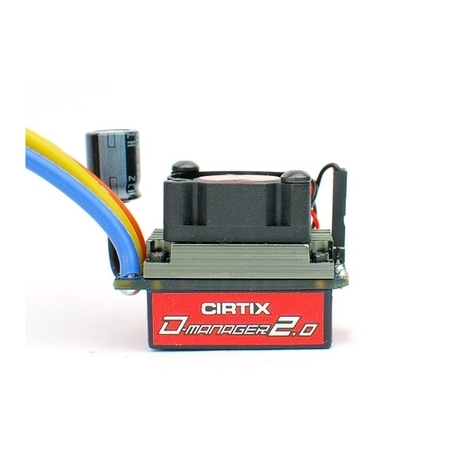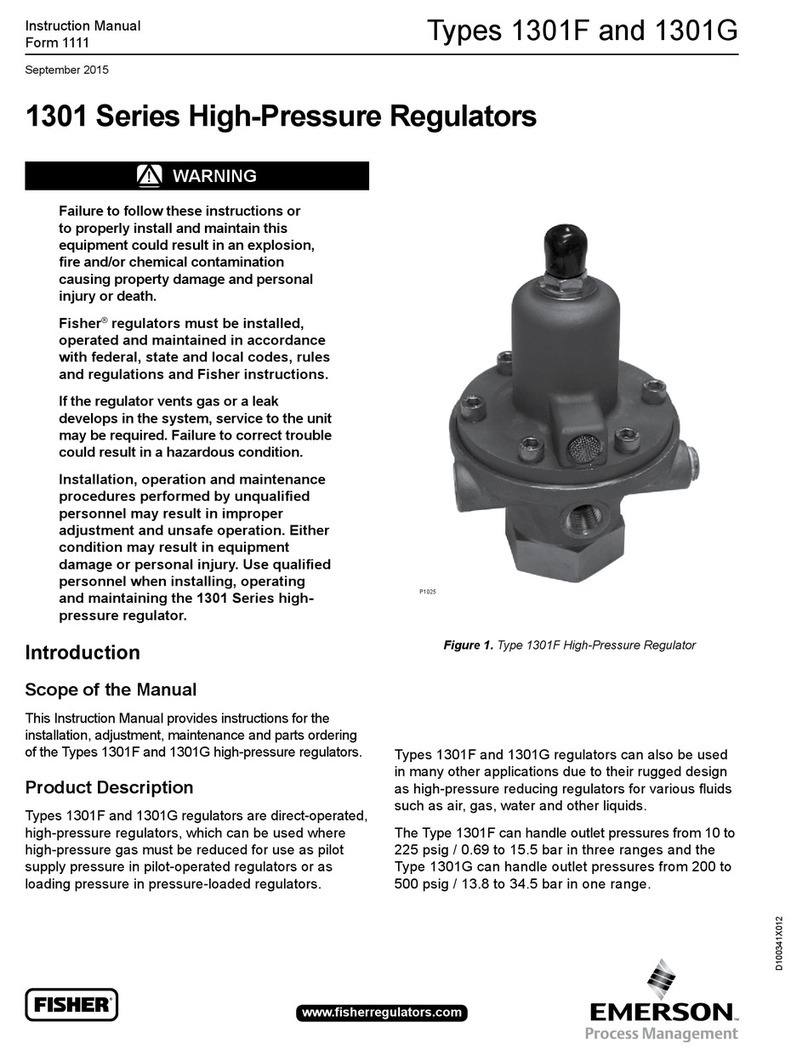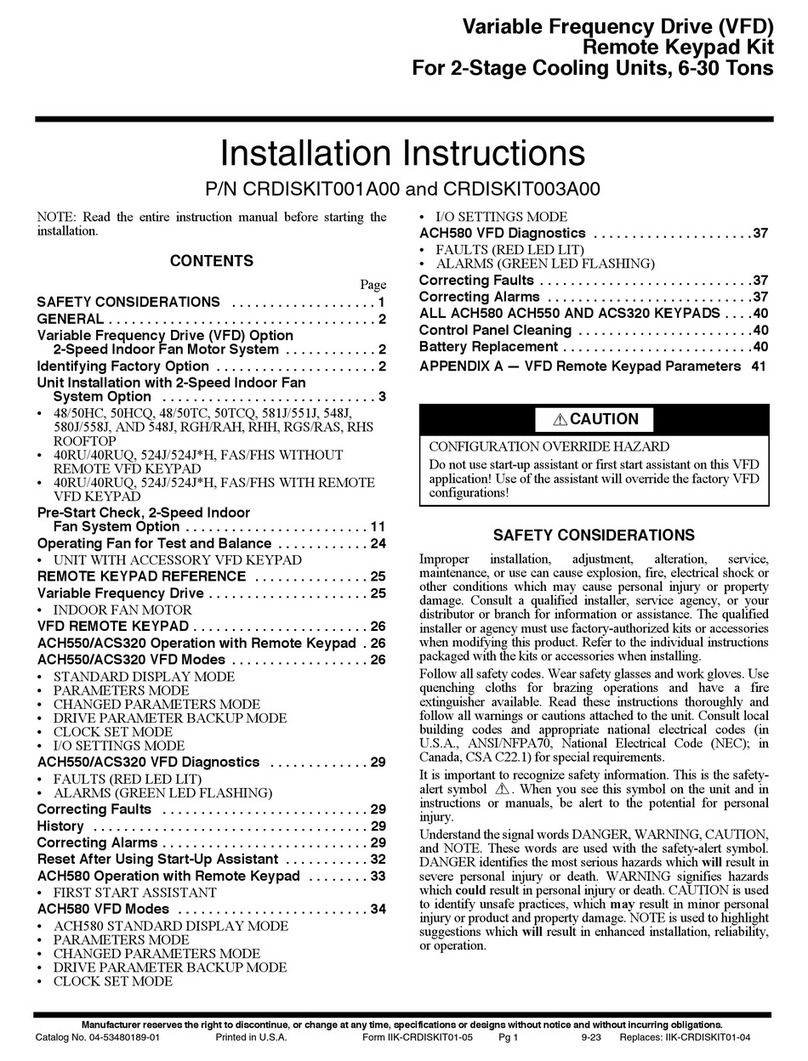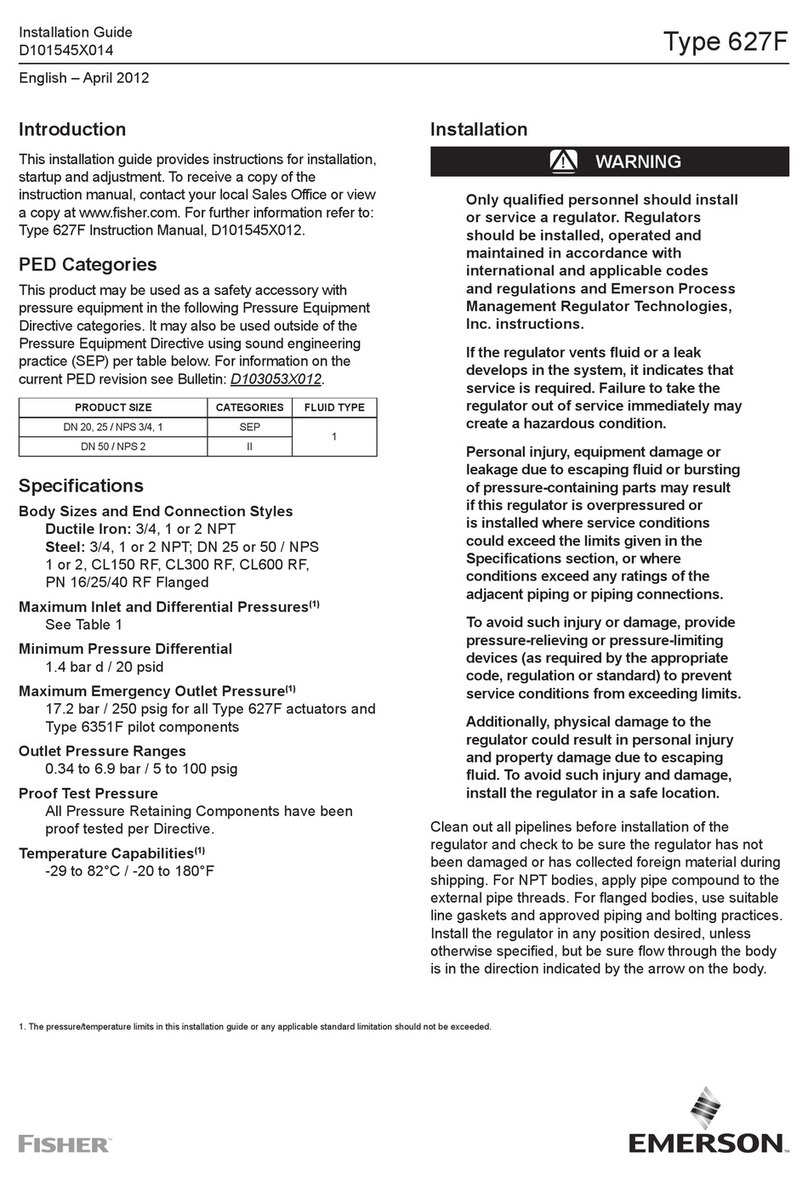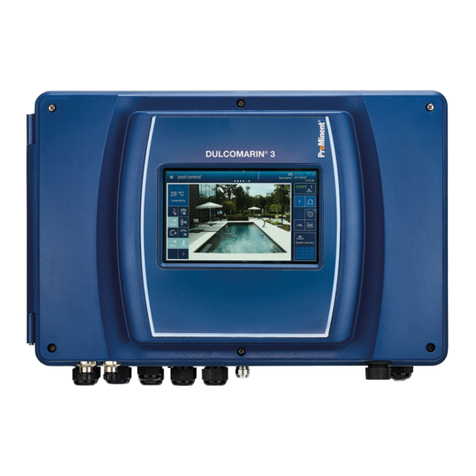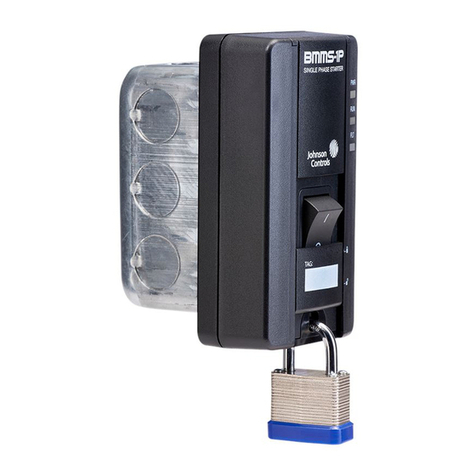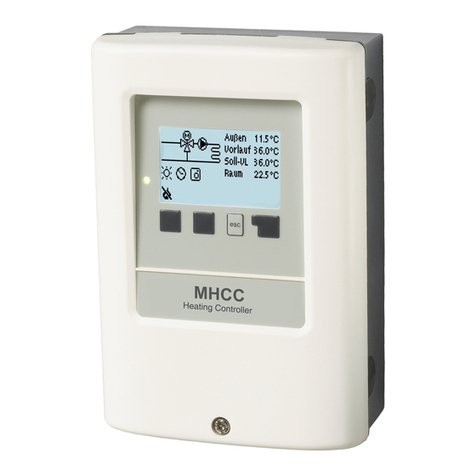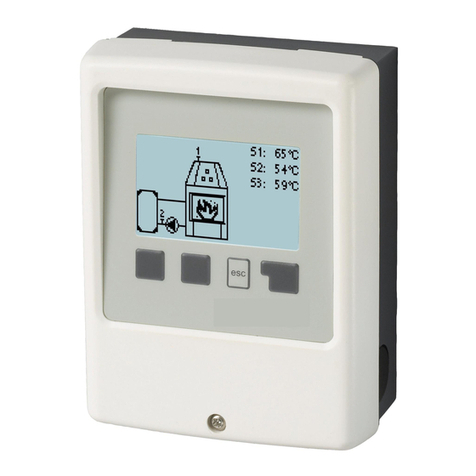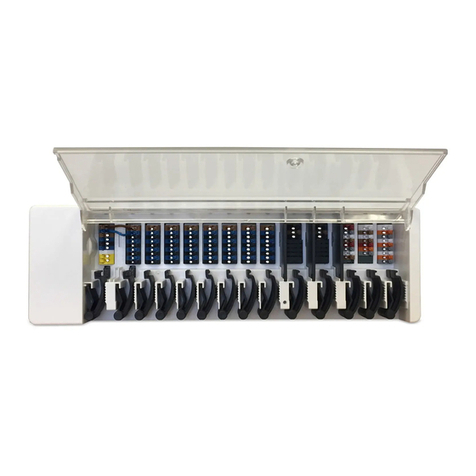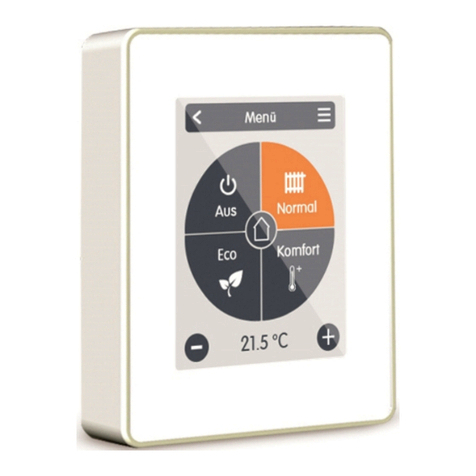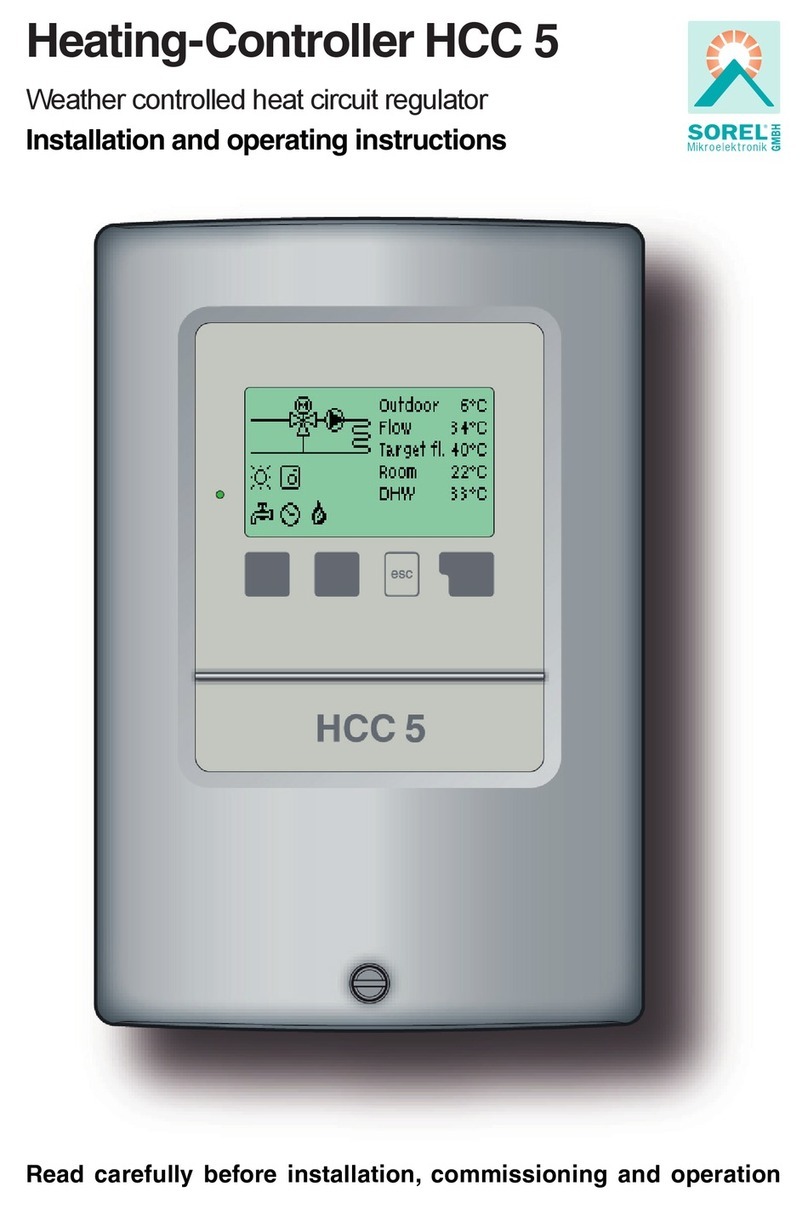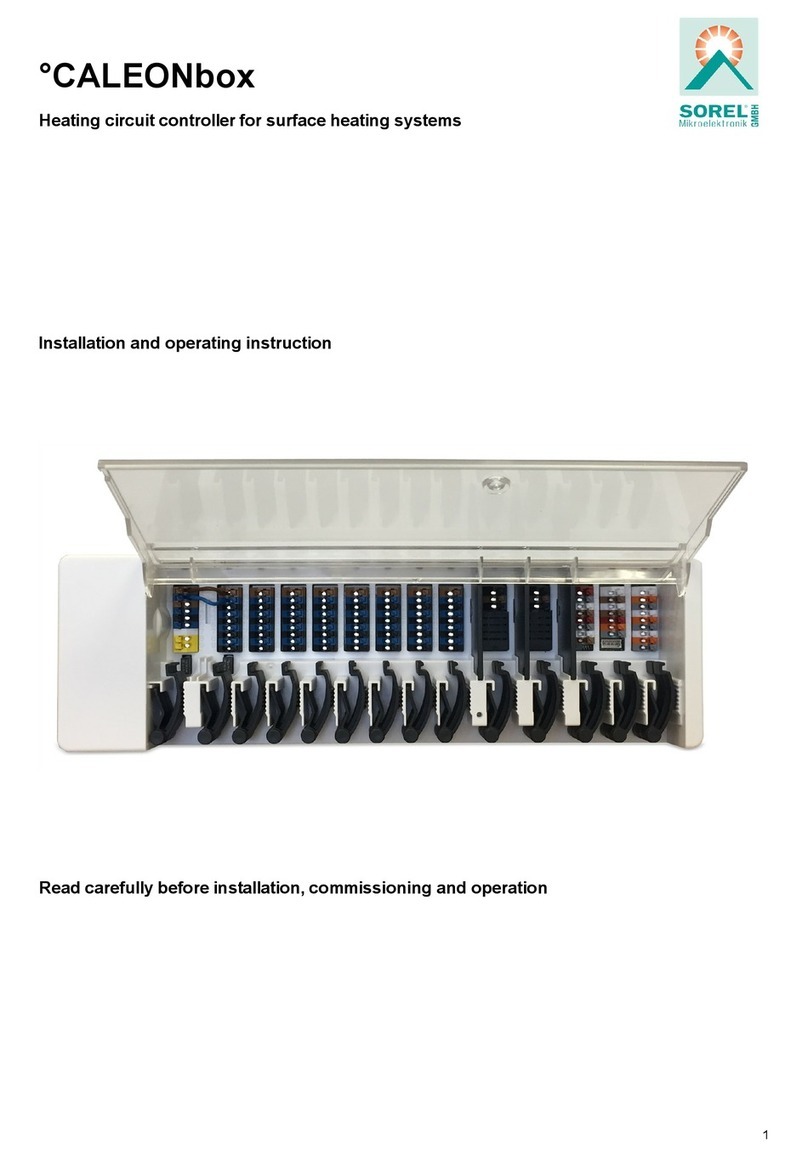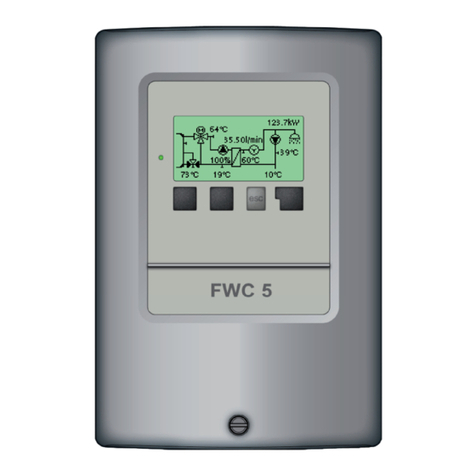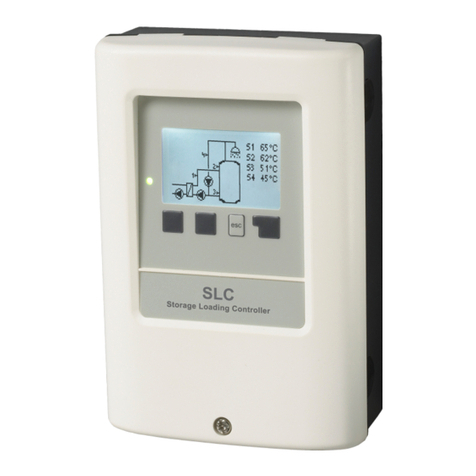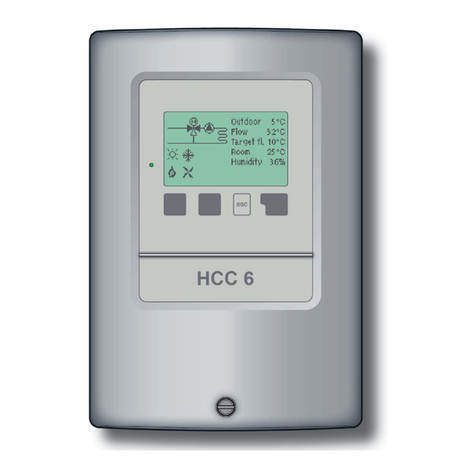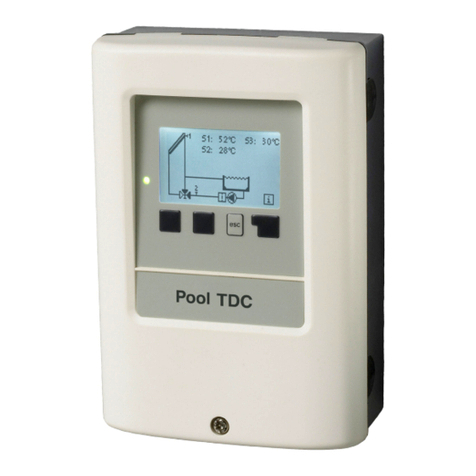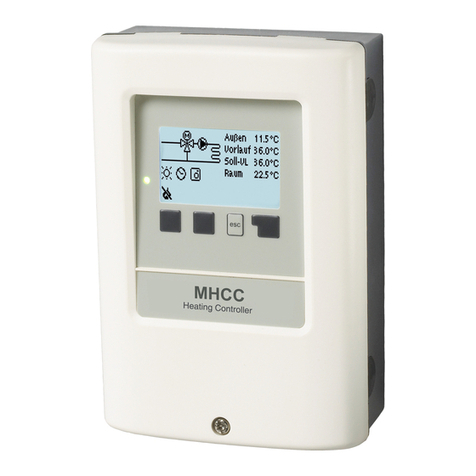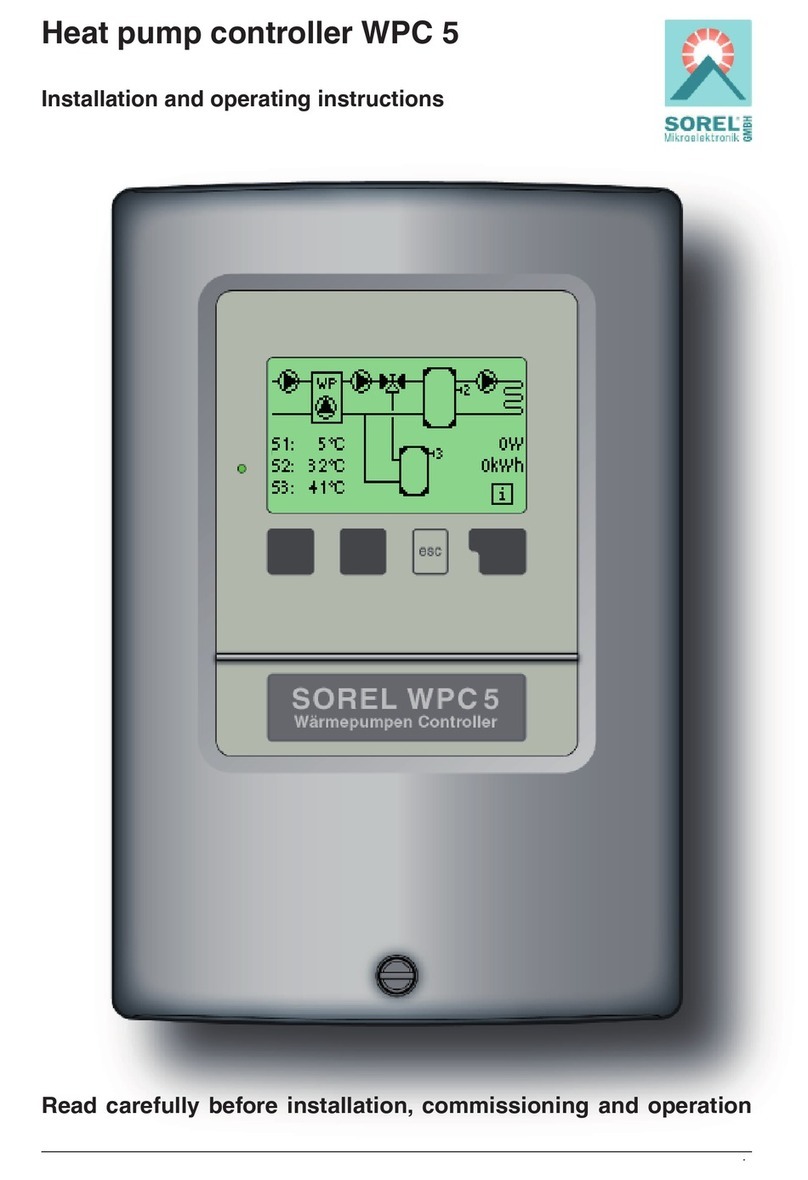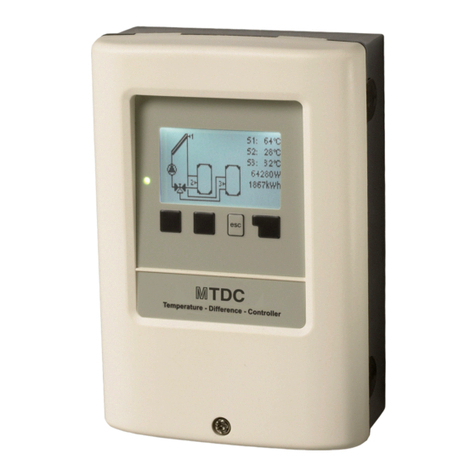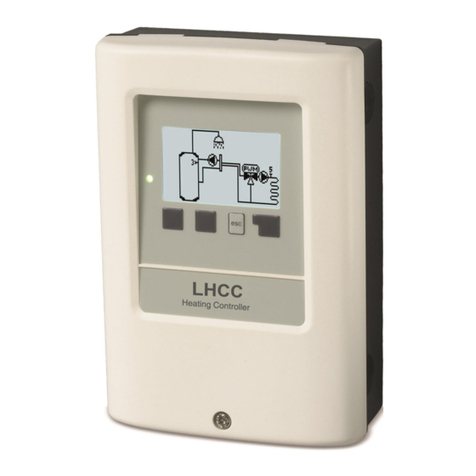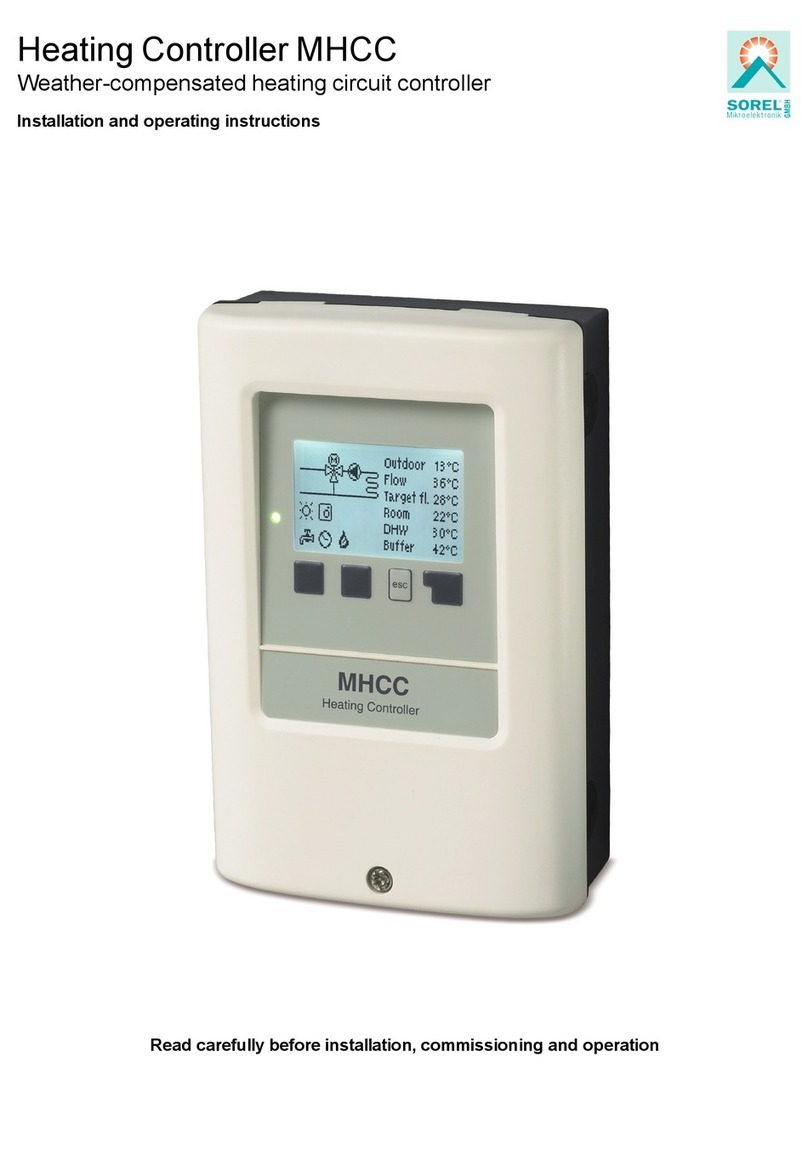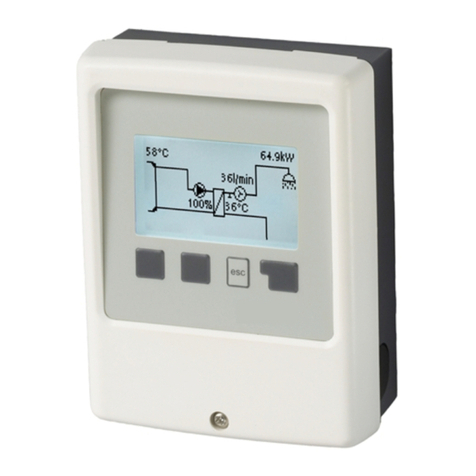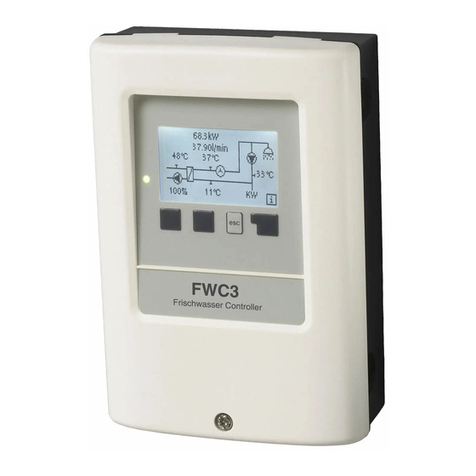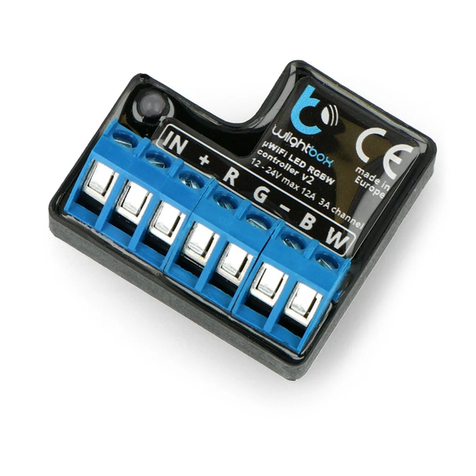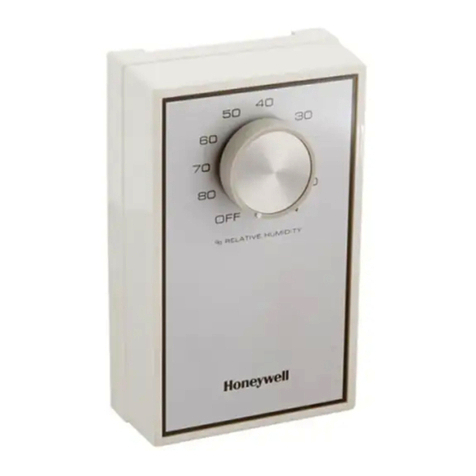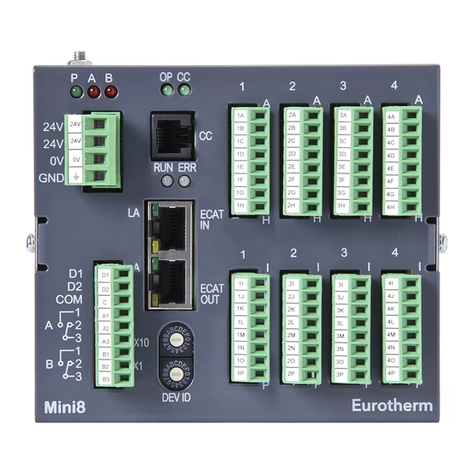
A. - Safety instructions 3
A.1. - EC declaration of conformity 3
A.2. - General instructions 3
A.3. - Explanation of symbols 3
A.4. - Changes to the unit 3
A.5. - Warranty and liability 4
A.6. - About the controller 4
A.7. - Scope of supply 4
A.8. - Disposal and pollutants 4
B. - Description of controller 5
B.1. - Speci cations 5
B.2. - Temperature resistance table for Pt1000 sensors 5
C. - Installation 6
C.1. - Wall installation 6
C.2. - Electrical connection 6
C.3. - Installing the temperature sensors 8
D. - Terminal connection 9
D.1. - Terminal connection 9
D.2. - Terminal connection diagram 9
D.3. - Hydraulic variants / Systems / Diagrams 10
D.4. - RC 21 Room thermostat and remote adjuster 12
E. - Operation 13
E.1. - Display and input 13
E.2. - Commissioning help 14
E.3. - Free commissioning 14
E.4 - Menu sequence and menu structure 15
1. - Measurement values 16
2. - Statistics 17
2.1. - Today 17
2.2. - 28 days 17
2.3. - Operating hours 17
2.4. - Heat quantity 17
2.5. - Graphic overview 17
2.6. - Message log 17
2.7. - Reset/clear 17
3. - Periods 18
3.1. - Heating circuit day 18
3.2. - Heating circuit 2 day 18
3.3. - Heating comfort 18
3.4. - Heating circuit 2 comfort 18
3.5. - Hot water enable 18
3.6. - Cooling periods 19
3.7. - Thermostat 19
3.8. - Circulation 19
3.9. - Antilegionella 19
3.10. - Time and Date 19
3.11. - Daylight saving time 19
4. - Operating Modes 20
4.1. - Heating circuit 20
4.2. - Manual 20
4.3. - Domestic Hot Water 20
5. - Settings 21
5.1. - Difference 21
5.2. - Heat Transfer 21
5.3. - Booster pump 21
5.4. - Thermostat 21
5.5. - Cooling 21
5.6. - Heating circuit 21
5.6.1. - Summer / Winter Day 21
5.6.2. - Summer / Winter Night 21
5.6.3. - Curve 22
5.6.4. - Day correction 22
5.6.5. - Night correction 22
5.6.6. - Comfort temperature boost 22
5.6.7. - Minimum Flow 23
5.6.8. - Maximum Flow 23
5.6.9. - Reference/actual - 23
5.6.10. - Reference/actual + 23
5.6.11. - Storage HC 23
5.7. - Solid fuel boiler 23
5.8. - Settings Domestic Hot Water (DHW) 23
5.8.1. - Hot water Minimum 23
5.8.2. - DHW reference 24
5.8.3. - DHW Hysteresis 24
5.8.4. - Buffer DHW charge 24
5.8.5. - DHW Priority 24
5.9. - Solar 24
5.10. - Solarbypass 24
5.11. - Heat exchanger 24
5.12. - Burner 24
5.13. - Boiler pump 24
5.14. - Compressor 24
5.15. - Glycol pump 24
5.16. - Storage loading pump 24
5.17. - Heating circuit 2 24
5.18. - Return ow increase 24
5.19. - Circulation 24
5.20. - Error messages 25
5.21. - Pressure control 25
5.22. - Parallel operation R1 25
5.23. - Parallel operation R2 25
5.24. - Mixer 25
5.24.1. - Turn time 25
5.24.2. - Pause factor 25
5.24.3. - Increase 25
5.25. - Room controller 25
5.25.1. - Room controller 25
5.25.2. - Room reference day 25
5.25.3. - Room reference night 25
5.25.4. - RC in uence 25
6. - Protective functions 26
6.1. - Anti-seizing protection 26
6.2. - Frost protection 26
6.3. - Antilegionella 27
6.3.1. - AL T set 27
6.3.2. - AL residence time 27
6.3.3. - Last AL heat up 27
6.3.4. - AL sensor 1 27
6.3.5. - AL Sensor 2 27
6.3.6. - AL-times 27
6.4. - Protective functions for Solar 28
6.5. - System protection 28
6.6. - Collector protection 28
6.6.1. - Recooling 28
6.6.2. - Frost protection 29
6.7. - Seizing protection 29
6.8. - Collector alarm 29
6.9 - Buffer Discharge protection 29
7. - Special functions 30
7.1. - Program selection 30
7.2. - Speed control 30
7.2.1. - Variant 30
7.2.2. - Type of pump 31
7.2.3. - Pump menu 31
7.2.3.1. - Pump 31
7.2.4. - Purging time 31
7.2.5. - Sweep time 31
7.2.6. - max. speed 31
7.2.7. - min. speed 31
7.3. - Relay functions 32
7.3.1. - Difference 32
7.3.1.1. - Difference 32
7.3.1.2. - ∆ T Difference 32
7.3.1.3. - DF source (sensor) 32
7.3.1.4. - Diff Tmin 32
7.3.1.5. - DF Drain (sensor) 32
7.3.1.6. - Diff Tmax 32
7.3.2. - Heat transfer 33
7.3.2.1. - ∆ T Heat transfer 33
7.3.2.2. - Setpoint 33
7.3.2.3. - HT Tmin 33
7.3.2.4. - HT Source (sensor) 33
7.3.2.5. - HT Drain (Target sensor) 33
7.3.3. - Booster pump 33
7.3.3.1. - Booster 33
7.3.3.2. - Fill time 33
7.3.4. - Thermostat 34
7.3.4.1. - Thermostat 34
7.3.4.2. - TH Set 34
7.3.4.3. - TH hysteresis 34
7.3.4.4. - Thermostat sensor 1 34
7.3.4.5. - Thermostat sensor 2 34
7.3.4.6. - T eco 34
7.3.4.7. - Energy saving mode 34
7.3.4.8. - Periods 34
7.3.5. - Cooling 35
7.3.5.1. - Cooling 35
7.3.5.2. - Co Tref 35
7.3.5.3. - Hysteresis 35
7.3.5.4. - Delay 35
7.3.5.5. - Cooling sensor 35
7.3.5.6. - Cooling periods 35
7.3.6. - Solid fuel boiler 36
7.3.6.1. - Solid fuel boiler 36
7.3.6.2. - SF Tmax 36
7.3.6.3. - SF Tmin 36
7.3.6.4. - ∆ T SF 36
7.3.6.5. - Boiler sensor 36
7.3.6.6. - Storage sensor 36
7.3.7. - Solar 37
7.3.7.1. - Solar 37
7.3.7.2. - Tmin S (X) 37
7.3.7.3. - ∆ T Solar S (X) 37
7.3.7.4. - Tmax S (X) 37
7.3.7.5. - Start aid function 37
7.3.7.6. - Protective functions 37
7.3.8. - Solar bypass 38
7.3.8.1. - Solar bypass 38
7.3.8.2. - Variant 38
7.3.8.3. - Bypass sensor 38
7.3.9. - Heat exchanger 38
7.3.9.1. - Heat exchanger 38
7.3.9.2. - HE sensor 38
7.3.10. - Burner 39
7.3.10.1. - Burner 39
7.3.10.2. - DHW request 39
7.3.10.3. - HC request 39
7.3.10.4. - Antilegionella 39
7.3.10.5. - Burner sensor 39
7.3.10.6. - Delay 39
7.3.10.7. - T eco DHW 39
7.3.10.8. - Burner offset 39
7.3.10.9. - Eco mode (during solar charge) 39
7.3.10.10. - Heating circuit offset 39
7.3.10.11. - BP Tmax 39
7.3.11. - Boiler pump 40
7.3.11.1. - Boiler pump 40
7.3.11.2. - BP Tmin 40
7.3.12. - Compressor 41
7.3.12.1. - Compressor 41
7.3.12.2. - DHW request 41
7.3.12.3. - HC request 41
7.3.12.4. - Heat pump run time 41
7.3.12.5. - Heat pump idle time 41
7.3.12.6. - Heat pump delay 41
7.3.12.7. - Periods 41
7.3.13. - Loading pump 41
7.3.13.1. - Loading pump 41
7.3.13.2. - Loading pump lag 41
7.3.14. - Glycol pump 41
7.3.14.1. - Glycol pump 41
7.3.14.2. - Gylcol pump lag 41
7.3.15. - Heating circuit 2 42
7.3.15.1. - Heating circuit 2 42
7.3.15.2. - S/W Day 42
7.3.15.3. - S/W Night 42
7.3.15.4. - Variant 42
7.3.15.5. - Curve 42
7.3.15.6. - Day correction 43
7.3.15.7. - Night correction 43
7.3.15.8. - Comfort temperature boost 43
7.3.15.9. - Minimum Flow 44
7.3.15.10. - Maximum Flow 44
7.3.15.11. - Reference/actual - 44
7.3.15.12. - Reference/actual + 44
7.3.15.13. - Outdoor sensor 44
7.3.15.14. - Flow sensor 44
7.3.16. - Return ow increase 45
7.3.16.1. - Return ow increase 45
7.3.16.2. - RF Tmin 45
7.3.16.3. - RF Tmax 45
7.3.16.4. - ∆T return ow 45
7.3.16.5. - Return ow (sensor) 45
7.3.16.6. - Storage (sensor) 45
7.3.17. - Domestic hot water valve 45
7.3.18. - Circulation 46
7.3.18.1. - Circulation 46
7.3.19.1. - Circulation Tmin 46
7.3.19.2. - Circulation hysteresis 46
7.3.19.3. - Circulation sensor 46
7.3.19.4. - Circulation pause time 46
7.3.19.5. - Purging time 46
7.3.19.6. - Circulations periods 46
7.3.19. - Messages 46
7.3.20. - Pressure monitor 47
7.3.20.1. - Pressure monitor 47
7.3.20.2. - RPS1 / RPS2 47
7.3.20.3. - Pmin 47
7.3.20.4. - Pmax 47
7.3.21. - Parallel operation R1 47
7.3.21.2. - Parallel operation R (X) 47
7.3.21.1. - Delay 47
7.3.21.3. - Followup time 47
7.3.23. - Always on 47
7.3.22. - Parallel operation R2 47
7.3.24. - Heat quantity 48
7.3.24.1. - Flow sensor (X) 48
7.3.24.2. - Return sensor 48
7.3.24.3. - Anti freeze type 48
7.3.24.4. - Glycole percentage 48
7.3.24.5. - Flow rate (X) 48
7.3.24.6. - Offset ∆ T 48
7.3.24.7. - VFS (X) 48
7.3.24.8. - VFS - Position 48
7.3.24.9. - Reference sensor 48
7.3.25. - Pressure monitor 49
7.3.26. - Pressure monitor 49
7.3.26.1. - RPS1 / RPS2 49
7.3.26.2. - Pmin 49
7.3.26.3. - Pmax 49
7.4. - Sensor calibration 49
7.5. - Commissioning 49
7.6. - Factory settings 49
7.7. - SD-Card 50
7.7.1. - Logging 50
7.7.2. - Free storage 50
7.7.3. - Load con guration 50
7.7.4. - Save con guration 50
7.7.5. - Firmware update 50
7.7.6. - Unmount 50
7.8. - Sleep mode 50
8. - Menu lock 51
9. - Service values 51
10. - Language 51
Z.1. Malfunctions with error messages 52
Z.2 Replacing the fuse 53
Z.3 Maintenance 53
K. - Appendix 54
K.1. - Pump 54
K.1.1. - Output Signal 54
K.1.2. - PWM off 54
K.1.3. - PWM on 54
K.1.4. - PWM Max 54
K.1.5. - 0-10V off 54
K.1.6. - 0-10V on 54
K.1.7. - 0-10V Max 54
K.1.8. - Speed when „On“ 54
K.1.9. - Show signal 54
Useful notes / Tips and tricks 56
Content




















